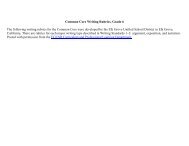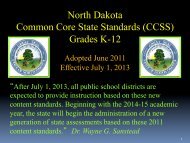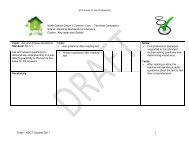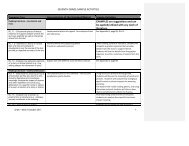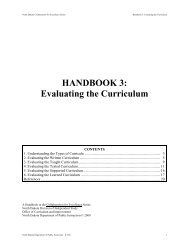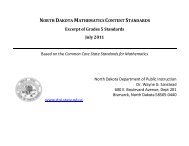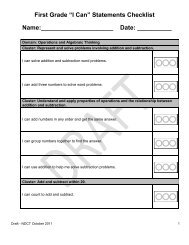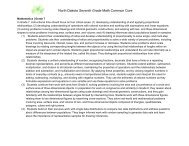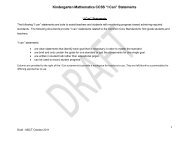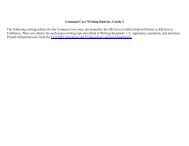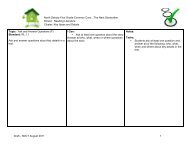ELA Grade 1 I Can Statements Draft - ND Curriculum Initiative
ELA Grade 1 I Can Statements Draft - ND Curriculum Initiative
ELA Grade 1 I Can Statements Draft - ND Curriculum Initiative
Create successful ePaper yourself
Turn your PDF publications into a flip-book with our unique Google optimized e-Paper software.
<strong>ELA</strong> <strong>Grade</strong> 1 I <strong>Can</strong> <strong>Statements</strong> <br />
North Dakota First <strong>Grade</strong> Common Core …The Next Generation<br />
Strand: Reading Literature<br />
Cluster: Key Ideas and Details<br />
Topic: Ask and Answer Questions<br />
(F)<br />
Standard: RL.1.1<br />
Ask and answer questions about key<br />
details in a text.<br />
I <strong>Can</strong>:<br />
• Ask at least one question about<br />
the story<br />
• Answer all who, what, when or<br />
where questions about the story<br />
Notes:<br />
Tasks:<br />
• Students ask at least one<br />
question and answer all of the<br />
following: who, what, when and<br />
where about key details in the<br />
text.<br />
Vocabulary:<br />
<strong>Draft</strong> – <strong>ND</strong>CT October 2011 1
<strong>ELA</strong> <strong>Grade</strong> 1 I <strong>Can</strong> <strong>Statements</strong> <br />
North Dakota <strong>Grade</strong> 1 Common Core …The Next Generation<br />
Strand: Reading Literature<br />
Cluster: Key Ideas and Details<br />
Topic: Retell stories<br />
Standard: RL.1.2<br />
Retell stories, including key details,<br />
and demonstrate understanding of<br />
their central message or lesson.<br />
Vocabulary:<br />
I <strong>Can</strong>:<br />
• Tell what the story is about and<br />
tell important parts<br />
Notes:<br />
Tasks:<br />
• Choose a story such as The<br />
Three Little Pigs. In a container<br />
have retelling props like a<br />
piece of straw, a piece of<br />
wood, and a brick. Children will<br />
retell the story using the props.<br />
After discussing the key<br />
details, the children will tell the<br />
lesson.<br />
<strong>Draft</strong> – <strong>ND</strong>CT October 2011 2
<strong>ELA</strong> <strong>Grade</strong> 1 I <strong>Can</strong> <strong>Statements</strong> <br />
North Dakota <strong>Grade</strong> 1 Common Core …The Next Generation<br />
Strand: Reading Literature<br />
Cluster: Key Ideas and Details<br />
Topic: Story Elements<br />
Standard: RL.1.3<br />
Describe characters, settings, and<br />
major events in a story, using key<br />
details<br />
Vocabulary:<br />
I <strong>Can</strong>:<br />
• Tell who was in the story, where it<br />
happened, when it happened and<br />
what happened<br />
Notes:<br />
• Comprehension strategies<br />
supported in this standard<br />
include monitoring<br />
understanding.<br />
Tasks:<br />
• Tell the students that fables<br />
are stories that teach us a<br />
lesson. The characters in the<br />
story are usually animals and<br />
have one main characteristic.<br />
Read the familiar fable, “The<br />
Tortoise and the Hare.” Ask<br />
students what they can tell you<br />
about the tortoise. (He’s slow,<br />
but steady.) What can they tell<br />
about the hare? (He’s fast, but<br />
undependable.) Create a chart<br />
with cells for the title,<br />
characters (with one<br />
characteristic each), setting,<br />
key events (i.e., from the<br />
beginning, middle, and end),<br />
and the lesson learned (i.e.,<br />
the moral of the story). As you<br />
read each fable in this unit,<br />
continue to fill in the chart.<br />
<strong>Draft</strong> – <strong>ND</strong>CT October 2011 3
<strong>ELA</strong> <strong>Grade</strong> 1 I <strong>Can</strong> <strong>Statements</strong> <br />
Give students more and more<br />
responsibility for filling in the<br />
characters, setting, and key<br />
events of a fable. Assess<br />
understanding at the end of the<br />
unit by reading a fable and<br />
then have each child write or<br />
dictate the entries on his or her<br />
own chart.<br />
Source commoncore.org<br />
<strong>Draft</strong> – <strong>ND</strong>CT October 2011 4
<strong>ELA</strong> <strong>Grade</strong> 1 I <strong>Can</strong> <strong>Statements</strong> <br />
North Dakota <strong>Grade</strong> 1 Common Core …The Next Generation<br />
Strand: Reading Literature<br />
Cluster: Craft and Structure<br />
Topic: Word Meaning within Text<br />
Standard: RL.1.4<br />
Identify words and phrases in stories<br />
or poems that suggest feelings or<br />
appeal to the senses.<br />
Vocabulary:<br />
I <strong>Can</strong>:<br />
• Tell how words make me feel<br />
Notes:<br />
• Comprehension strategies<br />
supported in this standard<br />
include making inferences.<br />
Tasks:<br />
• Read The Wizard of Oz by L.<br />
Frank Baum (see Common<br />
Core Appendix B for Chapter<br />
One text) aloud to the class.<br />
As students meet each<br />
character in the text, guide<br />
them to think about the<br />
character’s feelings and how<br />
the author shows us how the<br />
character feels. Discuss how<br />
the author helps us use our<br />
senses to see, smell, feel,<br />
hear, and even taste while we<br />
are reading a book. As you<br />
read aloud, model the way you<br />
are drawn to use your senses.<br />
For example, in the second<br />
paragraph of chapter one, the<br />
author describes Kansas so<br />
that you can “see” the<br />
countryside clearly. Then he<br />
goes on to describe Aunt Em,<br />
<strong>Draft</strong> – <strong>ND</strong>CT October 2011 5
<strong>ELA</strong> <strong>Grade</strong> 1 I <strong>Can</strong> <strong>Statements</strong> <br />
Uncle Henry, Toto, and<br />
Dorothy, with a focus on their<br />
feelings.<br />
Source: ADE/<strong>ELA</strong> Committee<br />
<strong>Draft</strong> – <strong>ND</strong>CT October 2011 6
<strong>ELA</strong> <strong>Grade</strong> 1 I <strong>Can</strong> <strong>Statements</strong> <br />
North Dakota <strong>Grade</strong> 1 Common Core …The Next Generation<br />
Strand: Reading Literature<br />
Cluster: Craft and Structure<br />
Topic: Text Structure<br />
Standard: RL.1.5<br />
Explain major differences between<br />
books that tell stories and books that<br />
give information, drawing on a wide<br />
reading of a range of text types.<br />
Vocabulary:<br />
I <strong>Can</strong>:<br />
• Tell which books are stories and<br />
which tell true things<br />
Notes:<br />
• Comprehension strategies<br />
supported in this standard<br />
include making connections.<br />
Tasks:<br />
• Teacher reads a fiction story<br />
and an expository book (The<br />
Mixed-Up Chameleon by Eric<br />
Carle, and Chameleons in the<br />
Garden by Mary Lovein. One<br />
tells a story and the other gives<br />
information. Students identify<br />
the clues that support the<br />
differences between fiction and<br />
nonfiction (e.g., bears wearing<br />
clothes, people don’t fly like<br />
birds).<br />
• Throughout this unit, students<br />
are reading from a variety of<br />
texts: stories, poems, and<br />
informational texts. When you<br />
have a ten-minute block, play<br />
“I Spy” with the children<br />
(e.g., “I spy an informational<br />
book,” “I spy a non-fiction<br />
book”). The students then have<br />
to guess which book you are<br />
looking at in the display of unit<br />
<strong>Draft</strong> – <strong>ND</strong>CT October 2011 7
<strong>ELA</strong> <strong>Grade</strong> 1 I <strong>Can</strong> <strong>Statements</strong> <br />
books.<br />
Source: ADE/<strong>ELA</strong> Committee<br />
<strong>Draft</strong> – <strong>ND</strong>CT October 2011 8
<strong>ELA</strong> <strong>Grade</strong> 1 I <strong>Can</strong> <strong>Statements</strong> <br />
North Dakota <strong>Grade</strong> 1 Common Core …The Next Generation<br />
Strand: Reading Literature<br />
Cluster: Craft and Structure<br />
Topic: Point of View<br />
Standard: RL.1.6<br />
Identify who is telling the story at<br />
various points in a text.<br />
Vocabulary:<br />
I <strong>Can</strong>:<br />
• Tell who is talking to tell the story<br />
Notes:<br />
Tasks:<br />
• Students become familiar with<br />
the concept of narrator and the<br />
use of dialogue. Teacher<br />
models changing a passage<br />
from narrative to dialogue:<br />
Narrative: She went to town.<br />
Dialogue: “I’m going to town.”<br />
• When reading aloud to<br />
students, model using different<br />
voices to help students identify<br />
who is speaking throughout the<br />
story.<br />
• As students read<br />
independently, remind them<br />
that different characters often<br />
tell the story at different times<br />
in a book. Using a book such<br />
as Mouse Tales by Arnold<br />
Lobel, allow the students to reread<br />
parts of the text where the<br />
weasel speaks, where the<br />
mouse speaks, and where the<br />
narrator tells the story. Provide<br />
a bowl of raw elbow macaroni<br />
at each table. Ask students to<br />
<strong>Draft</strong> – <strong>ND</strong>CT October 2011 9
<strong>ELA</strong> <strong>Grade</strong> 1 I <strong>Can</strong> <strong>Statements</strong> <br />
use the macaroni to cover the<br />
quotation marks in the book,<br />
reminding them that it means<br />
someone is speaking.<br />
Assigning the parts to three<br />
readers will show others how<br />
dialogue works in literature.<br />
Source: ADE/<strong>ELA</strong> Committee<br />
<strong>Draft</strong> – <strong>ND</strong>CT October 2011 10
<strong>ELA</strong> <strong>Grade</strong> 1 I <strong>Can</strong> <strong>Statements</strong> <br />
North Dakota <strong>Grade</strong> 1 Common Core …The Next Generation<br />
Strand: Reading Literature<br />
Cluster: Integration of Knowledge and Ideas<br />
Topic: Visuals and Text<br />
Standard: RL.1.7<br />
Use illustrations and details in a<br />
story to describe its characters,<br />
settings, or events.<br />
Vocabulary:<br />
I <strong>Can</strong>:<br />
• Tell about the story using pictures<br />
and words<br />
Notes:<br />
Tasks:<br />
• After reading a selection,<br />
complete a story map with<br />
characters, settings, and<br />
events while discussing how<br />
pictures and details clarified<br />
the story map.<br />
<strong>Draft</strong> – <strong>ND</strong>CT October 2011 11
<strong>ELA</strong> <strong>Grade</strong> 1 I <strong>Can</strong> <strong>Statements</strong> <br />
North Dakota <strong>Grade</strong> 1 Common Core …The Next Generation<br />
Strand: Reading Literature<br />
Cluster: Integration of Knowledge and Ideas<br />
Topic: Not applicable to literature<br />
Standard: RL.1.8<br />
Not applicable to Literature<br />
I <strong>Can</strong>:<br />
Notes:<br />
Vocabulary:<br />
Tasks:<br />
<strong>Draft</strong> – <strong>ND</strong>CT October 2011 12
<strong>ELA</strong> <strong>Grade</strong> 1 I <strong>Can</strong> <strong>Statements</strong> <br />
North Dakota <strong>Grade</strong> 1 Common Core …The Next Generation<br />
Strand: Reading Literature<br />
Cluster: Integration of Knowledge and Ideas<br />
Topic: Compare and Contrast<br />
Standard: RL.1.9<br />
Compare and contrast the<br />
adventures and experiences of<br />
characters in stories.<br />
Vocabulary:<br />
I <strong>Can</strong>:<br />
• Tell how stories are the same and<br />
different<br />
Notes:<br />
• Comprehension strategy<br />
supported in this standard<br />
include: making text-to-text<br />
connections and monitoring<br />
understanding.<br />
Tasks:<br />
• After reading or hearing two<br />
selections children prepare a<br />
Venn diagram (with support) or<br />
orally state similarities and<br />
differences.<br />
• Tell the students that the<br />
Indian fable, “The Blind Men<br />
and the Elephant” is the<br />
original telling of a fable more<br />
commonly known as “Seven<br />
Blind Mice.” Read the original<br />
story by Karen Backstein first,<br />
and then read Ed Young’s<br />
“Seven Blind Mice.” (Read<br />
aloud to students, or they may<br />
read on their own if they are<br />
able.) As the two fables are<br />
added to the story chart, ask<br />
the students to explain how<br />
<strong>Draft</strong> – <strong>ND</strong>CT October 2011 13
<strong>ELA</strong> <strong>Grade</strong> 1 I <strong>Can</strong> <strong>Statements</strong> <br />
these two stories are the same<br />
and how they are different.<br />
Source: ADE/<strong>ELA</strong> Committee<br />
<strong>Draft</strong> – <strong>ND</strong>CT October 2011 14
<strong>ELA</strong> <strong>Grade</strong> 1 I <strong>Can</strong> <strong>Statements</strong> <br />
North Dakota <strong>Grade</strong> 1 Common Core …The Next Generation<br />
Strand: Reading Literature<br />
Cluster: Range of Reading and Level of Text Complexity<br />
Topic: Text Complexity<br />
Standard: RL.1.10<br />
With prompting and support, read<br />
prose and poetry of appropriate<br />
complexity for grade 1.<br />
Vocabulary:<br />
I <strong>Can</strong>:<br />
• Read and listen to prose and<br />
poems<br />
Notes:<br />
• Prose is a type of literature<br />
without a formal pattern of<br />
verse or meter (not poetry).<br />
Poetry may include structure,<br />
meter and rhyme.<br />
Tasks<br />
• Expose children to prose and<br />
poetry, such as poetry written<br />
by Dennis Lee, Douglas<br />
Florian, and/or Shel Silverstein<br />
or prose written by Frank<br />
Ashe, Arnold Lobel, Mo<br />
Williams, Ted Arnold, and/or<br />
Elsie Holmelund Minarik.<br />
<strong>Draft</strong> – <strong>ND</strong>CT October 2011 15
<strong>ELA</strong> <strong>Grade</strong> 1 I <strong>Can</strong> <strong>Statements</strong> <br />
North Dakota <strong>Grade</strong> 1 Common Core …The Next Generation<br />
Strand: Reading Standards for Informational Texts<br />
Cluster: Key Ideas and Details<br />
Topic: Ask and Answer<br />
Questions<br />
Standard: RI.1.1<br />
Ask and answer<br />
questions about key<br />
details in a text.<br />
Vocabulary:<br />
I <strong>Can</strong>:<br />
• Ask questions about<br />
details in a text<br />
• Answer questions<br />
about details in a text<br />
Notes:<br />
• Comprehension strategies supported in this standard include<br />
asking questions.<br />
Tasks:<br />
• Teachers model asking questions (who, what, where, when, why,<br />
and how) to elicit student responses to informational text.<br />
Who? What? Where? Why? When? How?<br />
Source: commoncore.org<br />
<strong>Draft</strong> – <strong>ND</strong>CT October 2011 16
<strong>ELA</strong> <strong>Grade</strong> 1 I <strong>Can</strong> <strong>Statements</strong> <br />
North Dakota <strong>Grade</strong> 1 Common Core …The Next Generation<br />
Strand: Reading Standards for Informational Texts<br />
Cluster: Key Ideas and Details<br />
Topic: Main Topics and Key Details<br />
Standard: RI.1.2<br />
Identify the main topic and retell key<br />
details of a text.<br />
Vocabulary:<br />
I <strong>Can</strong>:<br />
• Tell important details Notes:<br />
• Comprehension strategies<br />
supported in this standard<br />
include synthesizing<br />
information.<br />
Tasks:<br />
• Tell the students that just<br />
because books are called<br />
“ABC books” it does not mean<br />
they are always easy to<br />
understand. Therefore, to<br />
understand them, we have to<br />
be willing to ask questions and<br />
to think deeply. Tell the<br />
students that they are going to<br />
look at The Graphic Alphabet<br />
by David Pelletier. On each<br />
page there is a letter, but<br />
there is more going on than<br />
just that letter. Look at “A.”<br />
Have the students ask<br />
questions about the page and<br />
try to answer them (e.g., “Why<br />
is the letter “A” crumbling?<br />
Could the letter be a<br />
mountain? Is that an<br />
<strong>Draft</strong> – <strong>ND</strong>CT October 2011 17
<strong>ELA</strong> <strong>Grade</strong> 1 I <strong>Can</strong> <strong>Statements</strong> <br />
‘avalanche’?”). There will be<br />
new vocabulary introduced,<br />
but as you go through the<br />
book and throughout the unit,<br />
students will have an<br />
opportunity to learn those<br />
words.<br />
Source: commoncore.org<br />
<strong>Draft</strong> – <strong>ND</strong>CT October 2011 18
<strong>ELA</strong> <strong>Grade</strong> 1 I <strong>Can</strong> <strong>Statements</strong> <br />
North Dakota <strong>Grade</strong> 1 Common Core …The Next Generation<br />
Strand: Reading Standards for Informational Texts<br />
Cluster: Key Ideas and Details<br />
Topic: Connections and<br />
Relationships in<br />
Informational Text<br />
Standard: RI.1.3<br />
Describe the connection<br />
between two individuals,<br />
events, ideas, or pieces<br />
of information in a text.<br />
Vocabulary:<br />
I <strong>Can</strong>:<br />
• Tell how things go<br />
together<br />
Notes:<br />
• Comprehension strategies supported in this standard include<br />
making connections<br />
Tasks:<br />
• Teachers provide graphic organizers (e.g., flowchart, timeline<br />
for events, webs-forming relationships from main ideas to<br />
others, main idea and supporting details).<br />
• Students highlight key details written on the graphic organizer.<br />
• Students restate the topic and support key details using the<br />
information from their graphic organizer.<br />
• Students read a section from a social studies or science<br />
informational text and identify the main topic and retell key<br />
details of the text.<br />
Main Topic<br />
Detail Detail Detail<br />
Conclusion<br />
Source: ADE/<strong>ELA</strong> Committee<br />
<strong>Draft</strong> – <strong>ND</strong>CT October 2011 19
<strong>ELA</strong> <strong>Grade</strong> 1 I <strong>Can</strong> <strong>Statements</strong> <br />
North Dakota <strong>Grade</strong> 1 Common Core …The Next Generation<br />
Strand: Reading Standards for Informational Texts<br />
Cluster: Craft and Structure<br />
Topic: Questioning and Clarifying<br />
Standard: RI.1.4<br />
Ask and answer questions to help<br />
determine or clarify the meaning of<br />
words and phrases in a text.<br />
Vocabulary:<br />
I <strong>Can</strong>:<br />
• Learn the meaning of words I do<br />
not know<br />
Notes:<br />
• Comprehension strategies<br />
supported in this standard<br />
include asking questions.<br />
Tasks:<br />
• Teachers model (think-aloud)<br />
how to identify and determine<br />
meanings of unknown words<br />
during shared reading of<br />
informational text.<br />
• Look at the illustration or<br />
graph.<br />
• Use background knowledge<br />
regarding the subject.<br />
• Look at the sentence before<br />
and after to help build<br />
meaning.<br />
• Use morphology, affixes,<br />
Greek & Latin roots to help<br />
arrive at meaning.<br />
Students keep word journals or<br />
records for easy reference<br />
<strong>Draft</strong> – <strong>ND</strong>CT October 2011 20
<strong>ELA</strong> <strong>Grade</strong> 1 I <strong>Can</strong> <strong>Statements</strong> <br />
North Dakota <strong>Grade</strong> 1 Common Core …The Next Generation<br />
Strand: Reading Standards for Informational Texts<br />
Cluster: Craft and Structure<br />
Topic: Text Features<br />
Standard: RI.1.5<br />
Know and use various text features<br />
(e.g. headings, table of contents,<br />
glossaries, electronic menus, icons)<br />
to locate key facts or information in a<br />
text.<br />
Vocabulary:<br />
I <strong>Can</strong>:<br />
• Use the parts of a book to find<br />
information<br />
Notes:<br />
• Comprehension strategies<br />
supported in this standard<br />
include determining<br />
importance.<br />
Tasks:<br />
• Give the students this prompt:<br />
“Write about your favorite<br />
animal. Be sure to include<br />
interesting facts about your<br />
animal and end with a solid<br />
closing. Allow your students to<br />
begin by working in teams to<br />
gather information. Using nonfictional<br />
texts, remind them to<br />
use the index or table of<br />
contents to locate more<br />
information about the animal.<br />
When they have some basic<br />
information, have them write<br />
the first draft. Ensure that<br />
adults are available to help<br />
with revision of the writing.<br />
Source: ADE/<strong>ELA</strong> Committee<br />
<strong>Draft</strong> – <strong>ND</strong>CT October 2011 21
<strong>ELA</strong> <strong>Grade</strong> 1 I <strong>Can</strong> <strong>Statements</strong> <br />
North Dakota <strong>Grade</strong> 1 Common Core …The Next Generation<br />
Strand: Reading Standards for Informational Texts<br />
Cluster: Craft and Structure<br />
Topic: Pictures and Words for<br />
Understanding<br />
Standard: RI.1.6<br />
Distinguish between information<br />
provided by pictures of other<br />
illustrations and information provided<br />
by the words in a text.<br />
Vocabulary:<br />
I <strong>Can</strong>:<br />
• Understand what is read<br />
because the pictures and words<br />
help me<br />
Notes:<br />
• Comprehension strategies<br />
supported in this standard<br />
include making connections<br />
and monitoring understanding.<br />
Tasks:<br />
• Use pictures and illustrations<br />
the author provided to clarify<br />
the information. (e.g., Why did<br />
the author put this graph in the<br />
text? What does the graph<br />
show us? How does this<br />
picture help you know what<br />
the author wanted you to<br />
understand?)<br />
<strong>Draft</strong> – <strong>ND</strong>CT October 2011 22
<strong>ELA</strong> <strong>Grade</strong> 1 I <strong>Can</strong> <strong>Statements</strong> <br />
North Dakota <strong>Grade</strong> 1 Common Core …The Next Generation<br />
Strand: Reading Standards for Informational Texts<br />
Cluster: Integration of Knowledge and Ideas<br />
Topic: Key Ideas and Details<br />
Standard: RI.1.7<br />
Use the illustrations and details in a<br />
text to describe its key ideas.<br />
Vocabulary:<br />
I <strong>Can</strong>:<br />
• Use the pictures and words to<br />
help understand ideas<br />
Notes:<br />
• Comprehension strategies<br />
supported in this standard<br />
include determining<br />
importance.<br />
Tasks:<br />
• Tell the students that just<br />
because books are called<br />
“ABC books” it does not mean<br />
they are always easy to<br />
understand. Therefore, to<br />
understand them, we have to<br />
be willing to ask questions and<br />
to think deeply. Tell the<br />
students that they are going to<br />
look at The Graphic Alphabet<br />
by David Pelletier On each<br />
page, there is a letter, but<br />
there is something more going<br />
on than just that letter. Look at<br />
“A.” Have the students ask<br />
questions about the page and<br />
try to answer them (e.g., “Why<br />
is the letter “A” crumbling?<br />
Could the letter be a<br />
mountain? Is that an<br />
‘avalanche’?”). There will be<br />
<strong>Draft</strong> – <strong>ND</strong>CT October 2011 23
<strong>ELA</strong> <strong>Grade</strong> 1 I <strong>Can</strong> <strong>Statements</strong> <br />
new vocabulary introduced,<br />
but as you go through the<br />
book and throughout the unit,<br />
students will have an<br />
opportunity to learn those<br />
words.<br />
Source: commoncore.org<br />
<strong>Draft</strong> – <strong>ND</strong>CT October 2011 24
<strong>ELA</strong> <strong>Grade</strong> 1 I <strong>Can</strong> <strong>Statements</strong> <br />
North Dakota <strong>Grade</strong> 1 Common Core …The Next Generation<br />
Strand: Reading Standards for Informational Texts<br />
Cluster: Integration of Knowledge and Ideas<br />
Topic: Supporting Details<br />
Standard: RI.1.8<br />
Identify the reasons an author gives<br />
to support points in a text.<br />
Vocabulary:<br />
I <strong>Can</strong>:<br />
• Tell some important things the<br />
author wanted me to learn<br />
Notes:<br />
Tasks:<br />
• The emphasis in this standard<br />
is how text is created with<br />
specific points or main ideas<br />
and it is supported by details<br />
or reasons. “Points in text”<br />
refers to main ideas and<br />
supporting details.<br />
• Teachers state main idea and<br />
ask students for supporting<br />
details.<br />
<strong>Draft</strong> – <strong>ND</strong>CT October 2011 25
<strong>ELA</strong> <strong>Grade</strong> 1 I <strong>Can</strong> <strong>Statements</strong> <br />
North Dakota <strong>Grade</strong> 1 Common Core …The Next Generation<br />
Strand: Reading Standards for Informational Texts<br />
Cluster: Integration of Knowledge and Ideas<br />
Topic: Similarities and Differences<br />
Standard: RI.1.9<br />
Identify basic similarities in and<br />
differences between two texts on the<br />
same topic (e.g. in illustrations,<br />
descriptions, or procedures).<br />
Vocabulary:<br />
I <strong>Can</strong>:<br />
• Tell how two texts are the same<br />
or different<br />
Notes:<br />
• Comprehension strategies<br />
supported in this standard<br />
include making text-to-text<br />
connections and determining<br />
importance.<br />
Tasks:<br />
• Read about animals of the<br />
Arctic and about animals of<br />
the Antarctic. Then, using a t-<br />
chart that contains the most<br />
important points, key details,<br />
similarities, and differences,<br />
compare the two informational<br />
texts.<br />
<strong>Draft</strong> – <strong>ND</strong>CT October 2011 26
<strong>ELA</strong> <strong>Grade</strong> 1 I <strong>Can</strong> <strong>Statements</strong> <br />
North Dakota <strong>Grade</strong> 1 Common Core …The Next Generation<br />
Strand: Reading Standards for Informational Texts<br />
Cluster: Range of Reading and Level of Text Complexity<br />
Topic: Text Complexity<br />
Standard: RI.1.10<br />
With prompting and support, read<br />
informational texts appropriately<br />
complex for grade 1.<br />
Vocabulary:<br />
I <strong>Can</strong>:<br />
• Read true stories with help<br />
Notes:<br />
Tasks:<br />
• Students will read<br />
informational texts (example<br />
biography of Abraham Lincoln)<br />
with support from their<br />
teacher.<br />
<strong>Draft</strong> – <strong>ND</strong>CT October 2011 27
<strong>ELA</strong> <strong>Grade</strong> 1 I <strong>Can</strong> <strong>Statements</strong> <br />
North Dakota <strong>Grade</strong> 1 Common Core …The Next Generation<br />
Strand: Foundational Skills<br />
Cluster: Print Concepts<br />
Topic: Concepts about print<br />
Standard: RF.1.1<br />
Demonstrate understanding of the<br />
organization and basic features of<br />
print.<br />
a) Recognize the distinguishing<br />
features of a sentence (e.g.,<br />
first word, capitalization,<br />
ending punctuation).<br />
Vocabulary:<br />
I <strong>Can</strong>:<br />
• Write a sentence that starts with<br />
a capital and ends with a mark<br />
Notes:<br />
Tasks:<br />
• Teachers provide sentences<br />
with convention errors (e.g.,<br />
capitals, punctuation) that have<br />
been explicitly taught. Students<br />
will identify and correct errors.<br />
• Students highlight basic<br />
feature of print in a passage<br />
(e.g., first word, capitalization,<br />
ending punctuation).<br />
Source: commoncore.org<br />
• Use questions and prompts<br />
such as:<br />
a) Show me the first word of<br />
the sentence.<br />
b) Where does the period<br />
(question mark, etc) go?<br />
c) Show me the capital letter.<br />
d) How does a sentence<br />
begin?<br />
e) What goes at the end of a<br />
sentence?<br />
Source: NCDE<br />
<strong>Draft</strong> – <strong>ND</strong>CT October 2011 28
<strong>ELA</strong> <strong>Grade</strong> 1 I <strong>Can</strong> <strong>Statements</strong> <br />
North Dakota <strong>Grade</strong> 1 Common Core …The Next Generation<br />
Strand: Foundational Skills<br />
Cluster: Phonological Awareness<br />
Topic: Spoken words, syllables and<br />
sounds<br />
Standard: RF.1.2<br />
Demonstrate understanding of<br />
spoken words, syllables, and sounds<br />
(phonemes).<br />
a) Distinguish long from short<br />
vowel sounds in spoken<br />
single-syllable words.<br />
b) Orally produce single-syllable<br />
words by blending sounds<br />
(phonemes), including<br />
consonant blends.<br />
c) Isolate and pronounce initial,<br />
medial vowel, and final<br />
sounds (phonemes) in spoken<br />
single-syllable words.<br />
d) Segment spoken singlesyllable<br />
words into their<br />
complete sequence of<br />
individual sounds<br />
(phonemes).<br />
Vocabulary:<br />
I <strong>Can</strong>:<br />
• Hear long and short vowels<br />
• Blend sounds to make words<br />
• Know beginning, middle, and<br />
ending sounds<br />
Notes:<br />
Tasks:<br />
• Use questions and prompts<br />
such as:<br />
a) Does this word have a long<br />
or short vowel sound?<br />
b) Say each sound you hear in<br />
this word slowly.<br />
c) What do you hear at the<br />
beginning of this word?<br />
What do you hear next? At<br />
the end?<br />
Source: NCDE<br />
<strong>Draft</strong> – <strong>ND</strong>CT October 2011 29
<strong>ELA</strong> <strong>Grade</strong> 1 I <strong>Can</strong> <strong>Statements</strong> <br />
North Dakota <strong>Grade</strong> 1 Common Core …The Next Generation<br />
Strand: Foundational Skills<br />
Cluster: Phonics and Word Recognition<br />
Topic: Decoding words/Phonics<br />
Standard: RF.1.3<br />
Know and apply grade-level phonics<br />
and word analysis skills in decoding<br />
words.<br />
a) Know the spelling-sound<br />
correspondences for common<br />
consonant digraphs.<br />
b) Decode regularly spelled onesyllable<br />
words.<br />
c) Know final –e and common<br />
vowel team conventions for<br />
representing long vowel<br />
sounds.<br />
d) Use knowledge that every<br />
syllable must have a vowel<br />
sound to determine the<br />
number of syllables in a<br />
printed word.<br />
e) Decode two-syllable words<br />
following basic patterns by<br />
breaking the words into<br />
syllables.<br />
f) Read words with inflectional<br />
endings.<br />
g) Recognize and read gradeappropriate<br />
irregularly spelled<br />
words.<br />
I <strong>Can</strong>:<br />
• Sound out one-syllable words<br />
• Sound out words that end with<br />
silent e.<br />
• Use vowels to sound out syllables<br />
• Break words into parts<br />
• Read words with endings<br />
• Read first grade sight words<br />
Notes:<br />
• Common vowel teams include:<br />
ai, ay, ee, ea, oa.<br />
Tasks:<br />
• Use questions and prompts<br />
such as:<br />
a) Does that sound right?<br />
b) Does that look right?<br />
c) Does that make sense?<br />
d) Look at the word, does it<br />
look like…?<br />
e) You said…does it look<br />
like…? What do these two<br />
letters sound like together<br />
(sh, th, ch) in this word?<br />
f) <strong>Can</strong> you clap the syllables<br />
in this word?<br />
g) What does this final e tell<br />
you about this word?<br />
h) Look at the beginning of<br />
that word, can you get it<br />
started?<br />
Source: NCDE<br />
<strong>Draft</strong> – <strong>ND</strong>CT October 2011 30
<strong>ELA</strong> <strong>Grade</strong> 1 I <strong>Can</strong> <strong>Statements</strong> <br />
Vocabulary:<br />
<strong>Draft</strong> – <strong>ND</strong>CT October 2011 31
<strong>ELA</strong> <strong>Grade</strong> 1 I <strong>Can</strong> <strong>Statements</strong> <br />
North Dakota <strong>Grade</strong> 1 Common Core …The Next Generation<br />
Strand: Foundational Skills<br />
Cluster: Fluency<br />
Topic: Accuracy, Fluency and<br />
Comprehension<br />
Standard: RF.1.4<br />
Read with sufficient accuracy and<br />
fluency to support comprehension.<br />
a) Read on-level text with<br />
purpose and understanding.<br />
b) Read on-level text orally with<br />
accuracy, appropriate rate,<br />
and expression on successive<br />
readings.<br />
Use context to confirm or selfcorrect<br />
word recognition and<br />
understanding, rereading as<br />
necessary.<br />
Vocabulary:<br />
I <strong>Can</strong>:<br />
• Understand what I read<br />
• Know the purpose of what I read<br />
• Read fluently<br />
• Self-correct when I read<br />
Notes:<br />
• Comprehension strategies<br />
supported in this standard<br />
include monitoring<br />
understanding.<br />
Tasks:<br />
• Model reading orally with<br />
fluency and accuracy, as well<br />
as expression and selfcorrecting.<br />
Also model the<br />
reading strategies (such as<br />
visualizing, background<br />
knowledge, important ideas,<br />
inferring, monitor and clarify,<br />
predict and set purpose,<br />
questioning, story structure,<br />
summarize, and text structure).<br />
• Use questions and prompts<br />
such as:<br />
a) Make your reading sound<br />
like the characters are<br />
talking.<br />
b) Make your voice sound like<br />
the words are together.<br />
c) Make your voice go up<br />
when you see the question<br />
mark at the end.<br />
d) Make your voice go down<br />
when you see the period at<br />
<strong>Draft</strong> – <strong>ND</strong>CT October 2011 32
<strong>ELA</strong> <strong>Grade</strong> 1 I <strong>Can</strong> <strong>Statements</strong> <br />
the end.<br />
e) Go back and reread when it<br />
doesn’t sound or look like<br />
you think it should.<br />
Source: NCDE<br />
<strong>Draft</strong> – <strong>ND</strong>CT October 2011 33
<strong>ELA</strong> <strong>Grade</strong> 1 I <strong>Can</strong> <strong>Statements</strong> <br />
North Dakota <strong>Grade</strong> 1 Common Core …The Next Generation<br />
Strand: Writing<br />
Cluster: Text Types and Purposes<br />
Topic: Opinions/Arguments<br />
Standard: W.1.1<br />
Write opinion pieces in which they<br />
introduce the topic or name the book<br />
they are writing about, state an<br />
opinion, supply a reason for the<br />
opinion, and provide some sense of<br />
closure.<br />
Vocabulary:<br />
I <strong>Can</strong>:<br />
• Write what I think and why I think<br />
that<br />
Notes:<br />
• Comprehension strategies<br />
supported in this standard<br />
include making connections.<br />
• See Appendix A, pages 24-25<br />
for more information about<br />
writing arguments.<br />
Tasks:<br />
• Students write a book review<br />
and write why they liked or did<br />
not like the book.<br />
• Students choose the better pet<br />
between a dog and a cat. They<br />
write a reason why and end<br />
with their opinion.<br />
<strong>Draft</strong> – <strong>ND</strong>CT October 2011 34
<strong>ELA</strong> <strong>Grade</strong> 1 I <strong>Can</strong> <strong>Statements</strong> <br />
North Dakota <strong>Grade</strong> 1 Common Core …The Next Generation<br />
Strand: Writing<br />
Cluster: Text Types and Purposes<br />
Topic: Informative/Explanatory<br />
Standard: W.1.2<br />
Write informative/explanatory texts<br />
in which they name a topic, supply<br />
some facts about the topic, and<br />
provide some sense of closure.<br />
Vocabulary:<br />
I <strong>Can</strong>:<br />
• Choose a real topic and write my<br />
facts<br />
Notes:<br />
• See Appendix A, pages 23-25<br />
for more information about<br />
writing arguments.<br />
Tasks:<br />
• Students choose a nonfiction<br />
topic and create one of the<br />
following: reports, definitions,<br />
lists, observations, journals,<br />
procedures, posters,<br />
pamphlets, news articles, or<br />
handouts.<br />
<strong>Draft</strong> – <strong>ND</strong>CT October 2011 35
<strong>ELA</strong> <strong>Grade</strong> 1 I <strong>Can</strong> <strong>Statements</strong> <br />
North Dakota <strong>Grade</strong> 1 Common Core …The Next Generation<br />
Strand: Writing<br />
Cluster: Text Types and Purposes<br />
Topic: Narrative<br />
Standard: W.1.3<br />
Write narratives in which they<br />
recount two or more appropriately<br />
sequenced events, include some<br />
details, regarding what happened,<br />
use temporal words to signal event<br />
order, and provide some sense of<br />
closure.<br />
Vocabulary:<br />
I <strong>Can</strong>:<br />
• Write about events that happened<br />
first, next, and last<br />
Notes:<br />
• See Appendix A, pages 23-25<br />
for more information about<br />
writing arguments.<br />
Tasks:<br />
• Students choose a nonfiction<br />
topic and create one of the<br />
following: reports, definitions,<br />
lists, observations, journals,<br />
procedures, posters, or news<br />
articles.<br />
<strong>Draft</strong> – <strong>ND</strong>CT October 2011 36
<strong>ELA</strong> <strong>Grade</strong> 1 I <strong>Can</strong> <strong>Statements</strong> <br />
North Dakota <strong>Grade</strong> 1 Common Core …The Next Generation<br />
Strand: Writing<br />
Cluster: Production and Distribution of Writing<br />
Topic:<br />
Revising Writing<br />
Standard: W.1.4<br />
Begins in 3 rd <strong>Grade</strong><br />
I <strong>Can</strong>:<br />
Notes:<br />
Vocabulary:<br />
Tasks:<br />
<strong>Draft</strong> – <strong>ND</strong>CT October 2011 37
<strong>ELA</strong> <strong>Grade</strong> 1 I <strong>Can</strong> <strong>Statements</strong> <br />
North Dakota <strong>Grade</strong> 1 Common Core …The Next Generation<br />
Strand: Writing<br />
Cluster: Production and Distribution of Writing<br />
Topic:<br />
Revising Writing<br />
Standard: W.1.5<br />
With guidance and support from<br />
adults, focus on a topic, respond to<br />
questions and suggestions from<br />
peers, and add details to strengthen<br />
writing as needed.<br />
Vocabulary:<br />
I <strong>Can</strong>:<br />
• Use suggestions to add details to<br />
make my writing better<br />
Notes:<br />
• Comprehension strategies<br />
supported in this standard<br />
include determining<br />
importance.<br />
Tasks:<br />
• After completing a rough draft<br />
on a chosen topic, share with<br />
teacher and peers to hear<br />
suggestions for adding details.<br />
Students will then revise as<br />
needed to strengthen writing.<br />
<strong>Draft</strong> – <strong>ND</strong>CT October 2011 38
<strong>ELA</strong> <strong>Grade</strong> 1 I <strong>Can</strong> <strong>Statements</strong> <br />
North Dakota <strong>Grade</strong> 1 Common Core …The Next Generation<br />
Strand: Writing<br />
Cluster: Text Types and Purposes<br />
Topic:<br />
Digital Publishing<br />
Standard: W.1.6<br />
With guidance and support from<br />
adults, use a variety of digital tools<br />
to produce and publish writing,<br />
including in collaboration with peers.<br />
Vocabulary:<br />
I <strong>Can</strong>:<br />
• Share my writing with technology<br />
Notes:<br />
• Comprehension strategies<br />
supported in this standard<br />
include determining<br />
importance.<br />
Tasks:<br />
• As a class (or individually),<br />
create digital stories using<br />
PowerPoint, the Internet,<br />
Kidspiration, Kid Pix, etc.<br />
<strong>Draft</strong> – <strong>ND</strong>CT October 2011 39
<strong>ELA</strong> <strong>Grade</strong> 1 I <strong>Can</strong> <strong>Statements</strong> <br />
North Dakota <strong>Grade</strong> 1 Common Core …The Next Generation<br />
Strand: Writing<br />
Cluster: Research to Build and Present Knowledge<br />
Topic:<br />
Shared Research and Writing<br />
Standard: W.1.7<br />
Participate in shared research and<br />
writing projects (e.g., explore a<br />
number of “how-to” books on a given<br />
topic and use them to write a<br />
sequence of instructions).<br />
Vocabulary:<br />
I <strong>Can</strong>:<br />
• Find facts<br />
• Write a book with my classmates<br />
Notes:<br />
• Comprehension strategies<br />
supported in this standard<br />
include determining<br />
importance.<br />
Tasks:<br />
• Read books about forest<br />
animals or farm animals. Have<br />
children list some facts and<br />
choose two or three facts<br />
about a few animals and write<br />
a class book.<br />
<strong>Draft</strong> – <strong>ND</strong>CT October 2011 40
<strong>ELA</strong> <strong>Grade</strong> 1 I <strong>Can</strong> <strong>Statements</strong> <br />
North Dakota <strong>Grade</strong> 1 Common Core …The Next Generation<br />
Strand: Writing<br />
Cluster: Research to Build and Present Knowledge<br />
Topic:<br />
Use sources to answer questions.<br />
Standard: W.1.8<br />
With guidance and support from<br />
adults, recall information from<br />
experiences or gather information<br />
from provided sources to answer a<br />
question.<br />
Vocabulary:<br />
I <strong>Can</strong>:<br />
• Write an answer to a question<br />
Notes:<br />
• Comprehension strategies<br />
supported in this standard<br />
include making connections,<br />
synthesizing information, and<br />
determining importance.<br />
Tasks:<br />
• With a question in mind, listen<br />
to or read books on the topics<br />
and write an answer to<br />
question such as, “How are<br />
frogs different from toads?”<br />
<strong>Draft</strong> – <strong>ND</strong>CT October 2011 41
<strong>ELA</strong> <strong>Grade</strong> 1 I <strong>Can</strong> <strong>Statements</strong> <br />
North Dakota <strong>Grade</strong> 1 Common Core …The Next Generation<br />
Strand: Speaking and Listening<br />
Cluster: Comprehension and Collaboration<br />
Topic:<br />
Conversation<br />
Standard:SL.1.1<br />
Participation in collaborative<br />
conversations with diverse partners<br />
about grade 1 topics and texts with<br />
peers and adults in small and larger<br />
groups.<br />
a. Follow agreed-upon rules for<br />
discussions (e.g., listening to<br />
others with care, speaking<br />
one at a time about the<br />
topics and texts under<br />
discussion).<br />
b. Build on others’ talk in<br />
conversations by responding<br />
to the comments of others<br />
through multiple exchanges.<br />
c. Ask questions to clear up any<br />
confusion about the topics<br />
and texts under discussion.<br />
I <strong>Can</strong>:<br />
• Follow rules when I talk with my<br />
classmates<br />
• Ask questions about the topic<br />
• Add my own comments to the<br />
topic<br />
Notes:<br />
• Comprehension strategies<br />
supported in this standard<br />
include asking questions.<br />
Tasks:<br />
• Using the ABC books as a<br />
model, generate some ideas<br />
for writing a class ABC book.<br />
Work together as a class to<br />
come up with a big class<br />
question. Begin by asking<br />
questions such as, “Is it<br />
possible to create an ABC<br />
book with ‘Games to Play’ as<br />
our title?” Allow the class to<br />
give some ideas (e.g., names,<br />
authors, books, plants, and<br />
insects). After ideas have<br />
been shaped into a research<br />
question, allow the children to<br />
vote on a theme for the class<br />
ABC book. Once the theme is<br />
<strong>Draft</strong> – <strong>ND</strong>CT October 2011 42
<strong>ELA</strong> <strong>Grade</strong> 1 I <strong>Can</strong> <strong>Statements</strong> <br />
Vocabulary:<br />
chosen, collect (and research<br />
using a variety of texts and<br />
digital resources) ideas for<br />
each letter of the alphabet.<br />
Decide on a design for the<br />
book. Assign each student a<br />
letter in the book. Each page<br />
should include an upper and<br />
lower case letter, the key<br />
word, an illustration, and a<br />
sentence using the key word.<br />
Be sure to have them follow<br />
rules for spelling and<br />
punctuating correctly.<br />
Source: commoncore.org<br />
<strong>Draft</strong> – <strong>ND</strong>CT October 2011 43
<strong>ELA</strong> <strong>Grade</strong> 1 I <strong>Can</strong> <strong>Statements</strong> <br />
North Dakota <strong>Grade</strong> 1 Common Core …The Next Generation<br />
Strand: Speaking and Listening<br />
Cluster: Comprehension and Collaboration<br />
Topic:<br />
Listening Comprehension<br />
Standard: SL1.2<br />
Ask and answer questions about key<br />
details in a text read aloud or<br />
information presented orally or<br />
through other media.<br />
Vocabulary:<br />
I <strong>Can</strong>:<br />
• Ask and answer questions to<br />
learn more about something<br />
Notes:<br />
• Comprehension strategies<br />
supported in this standard<br />
include determining<br />
importance.<br />
Tasks:<br />
• Look at a piece of art,<br />
photograph, or illustration.<br />
Have children brainstorm<br />
questions about the media.<br />
Record questions on a chart<br />
and have children think deeply<br />
to answer questions that were<br />
generated. Discuss the value<br />
in asking questions to help<br />
understand the topic.<br />
<strong>Draft</strong> – <strong>ND</strong>CT October 2011 44
<strong>ELA</strong> <strong>Grade</strong> 1 I <strong>Can</strong> <strong>Statements</strong> <br />
North Dakota <strong>Grade</strong> 1 Common Core …The Next Generation<br />
Strand: Speaking and Listening<br />
Cluster: Comprehension and Collaboration<br />
Topic:<br />
Listen and Respond<br />
Standard:SL.1.3<br />
Ask and answer questions about<br />
what a speaker says in order to<br />
gather additional information or<br />
clarify something that is not<br />
understood.<br />
Vocabulary:<br />
I <strong>Can</strong>:<br />
• Ask good questions after listening<br />
to someone speak<br />
Notes:<br />
• Comprehension strategies<br />
supported in this standard<br />
include asking questions.<br />
Tasks:<br />
• Discuss the difference<br />
between quality questions and<br />
stories. Then, invite a guest<br />
speaker into the classroom<br />
(such as a dental hygienist,<br />
police, or nurse). Allow<br />
students to ask quality<br />
questions.<br />
<strong>Draft</strong> – <strong>ND</strong>CT October 2011 45
<strong>ELA</strong> <strong>Grade</strong> 1 I <strong>Can</strong> <strong>Statements</strong> <br />
North Dakota <strong>Grade</strong> 1 Common Core …The Next Generation<br />
Strand: Speaking and Listening<br />
Cluster: Presentation of Knowledge and Ideas<br />
Topic:<br />
Oral Expression<br />
Standard: SL.1.4<br />
Describe people, places, things, and<br />
events with relevant details,<br />
expressing ideas and feelings<br />
clearly.<br />
Vocabulary:<br />
I <strong>Can</strong>:<br />
• Express my ideas and feelings<br />
clearly<br />
Notes:<br />
• Comprehension strategies<br />
supported in this standard<br />
include making connections.<br />
Tasks:<br />
• Tell students to stand up and<br />
walk around. Then, tell them<br />
to walk like they are going out<br />
to ice cream having them note<br />
how their gaits changes. Next,<br />
tell them they should walk<br />
after they got in trouble, again,<br />
note how their gaits change.<br />
Continue this game as time<br />
permits with other scenarios.<br />
When finished, discuss how<br />
feelings changed using<br />
descriptive language (i.e.<br />
excited instead of happy).<br />
Record responses on chart.<br />
<strong>Draft</strong> – <strong>ND</strong>CT October 2011 46
<strong>ELA</strong> <strong>Grade</strong> 1 I <strong>Can</strong> <strong>Statements</strong> <br />
North Dakota <strong>Grade</strong> 1 Common Core …The Next Generation<br />
Strand: Speaking and Listening<br />
Cluster: Presentation of Knowledge and Ideas<br />
Topic:<br />
Multimedia Presentations<br />
Standard: SL.1.5<br />
Add drawings or other visual<br />
displays to descriptions when<br />
appropriate to clarify ideas,<br />
thoughts, and feeling.<br />
Vocabulary:<br />
I <strong>Can</strong>:<br />
• Use pictures or things to help<br />
people understand me<br />
Notes:<br />
• Comprehension strategies<br />
supported in this standard<br />
include visualizing.<br />
Tasks:<br />
• Ask the students to think about<br />
how all of the Cinderella<br />
stories are different because<br />
of the time and place where<br />
they happen. Challenge the<br />
students to draw the "trying on<br />
the slipper" scene as if it were<br />
happening right now and in the<br />
place where they live. Scan<br />
the pictures and create a<br />
Power Point slide for each<br />
image. Students<br />
present their drawings to<br />
the class explaining their<br />
adaptation of the “slipper<br />
scene.”<br />
Source: commoncore.org<br />
<strong>Draft</strong> – <strong>ND</strong>CT October 2011 47
<strong>ELA</strong> <strong>Grade</strong> 1 I <strong>Can</strong> <strong>Statements</strong> <br />
North Dakota <strong>Grade</strong> 1 Common Core …The Next Generation<br />
Strand: Speaking and Listening<br />
Cluster: Presentation of Knowledge and Ideas<br />
Topic:<br />
Appropriate Oral Communication<br />
Standard: SL.1.6<br />
Produce complete sentences when<br />
appropriate to task and situation.<br />
(See grade 1 Language standards 1<br />
and 3 on page 26 for specific<br />
expectations).<br />
Vocabulary:<br />
I <strong>Can</strong>:<br />
• Talk in sentences<br />
Notes:<br />
Tasks:<br />
• Model incomplete sentences.<br />
Discuss what is missing in<br />
those incomplete sentences.<br />
As a group, recreate the<br />
incomplete thought into a<br />
quality sentence. Group<br />
students and give them<br />
incomplete sentences to<br />
transform into quality<br />
sentences. Discuss examples<br />
with group.<br />
<strong>Draft</strong> – <strong>ND</strong>CT October 2011 48
<strong>ELA</strong> <strong>Grade</strong> 1 I <strong>Can</strong> <strong>Statements</strong> <br />
North Dakota <strong>Grade</strong> 1 Common Core …The Next Generation<br />
Strand: Language<br />
Cluster: Conventions of Standard English<br />
Topic: Grammar Usage<br />
Standard: L.1.1<br />
Demonstrate command of the<br />
conventions of standard English<br />
grammar and usage when writing or<br />
speaking.<br />
a) Print all upper- and lowercase<br />
letters.<br />
b) Use common, proper, and<br />
possessive nouns.<br />
c) Use singular and plural nouns<br />
with matching verbs in basic<br />
sentences (e.g., He hops; We<br />
hop).<br />
d) Use personal, possessive, and<br />
indefinite pronouns (e.g., I, me,<br />
my; they, them, their, anyone,<br />
everything).<br />
e) Use verbs to convey a sense<br />
of past, present, and future<br />
(e.g., Yesterday I walked<br />
home; Today I walk home;<br />
Tomorrow I will walk home).<br />
f) Use frequently occurring<br />
adjectives.<br />
g) Use frequently occurring<br />
conjunctions (e.g., and, but, or,<br />
I <strong>Can</strong>:<br />
• Print all upper- and lowercase<br />
letters<br />
• Know what nouns are<br />
• Match nouns with action words<br />
(He hops. We hop.)<br />
• Use a different word for a noun<br />
(I, me, my; they, them, their,<br />
anyone, everything)<br />
• Use action words for things that<br />
happened yesterday, today, and<br />
tomorrow<br />
• Use describing words<br />
• Use connecting words<br />
• Use a, an, and the<br />
• Use prepositions like over, under,<br />
and, around<br />
• Combine sentences<br />
Notes:<br />
• Adjectives include size, shape,<br />
and color words<br />
Tasks:<br />
• Using the ABC books as a<br />
model, generate some ideas<br />
for writing a class ABC book.<br />
Work together as a class to<br />
come up with a big class<br />
question. Begin by asking<br />
questions such as, “Is it<br />
possible to create an ABC<br />
book with ‘Games to Play’ as<br />
our title?” Allow the class to<br />
give some ideas (e.g., names,<br />
authors, books, plants,<br />
insects). After ideas have been<br />
shaped into a research<br />
question, allow the children to<br />
vote on a theme for the class<br />
ABC book. Once the theme is<br />
chosen, collect (and research<br />
using a variety of texts and<br />
digital resources) ideas for<br />
each letter of the alphabet.<br />
Decide on a design for the<br />
<strong>Draft</strong> – <strong>ND</strong>CT October 2011 49
<strong>ELA</strong> <strong>Grade</strong> 1 I <strong>Can</strong> <strong>Statements</strong> <br />
so, because).<br />
h) Use determiners (e.g., articles,<br />
demonstratives).<br />
i) Use frequently occurring<br />
prepositions (e.g., during,<br />
beyond, toward).<br />
Produce and expand complete<br />
simple and compound declarative,<br />
interrogative, imperative, and<br />
exclamatory sentences in response<br />
to prompts.<br />
book. Assign each student a<br />
letter in the book. Each page<br />
should include an upper and<br />
lower case letter, the key word,<br />
an illustration, and a sentence<br />
using the key word. Be sure to<br />
have them follow rules for<br />
spelling and punctuating<br />
correctly.<br />
Source:commoncore.org<br />
Vocabulary:<br />
<strong>Draft</strong> – <strong>ND</strong>CT October 2011 50
<strong>ELA</strong> <strong>Grade</strong> 1 I <strong>Can</strong> <strong>Statements</strong> <br />
North Dakota <strong>Grade</strong> 1 Common Core …The Next Generation<br />
Strand: Language<br />
Cluster: Conventions of Standard English<br />
Topic: Capitalization, Punctuation<br />
and Spelling<br />
Standard: L.1.2<br />
Demonstrate command of the<br />
conventions of standard English<br />
capitalization, punctuation, and<br />
spelling when writing.<br />
a) Capitalize dates and names<br />
of people.<br />
b) Use end punctuation for<br />
sentences.<br />
c) Use commas in dates and to<br />
separate single words in a<br />
series.<br />
d) Use conventional spelling for<br />
words with common spelling<br />
patterns and for frequently<br />
occurring irregular words.<br />
e) Spell untaught words<br />
phonetically, drawing on<br />
phonemic awareness and<br />
spelling conventions.<br />
I <strong>Can</strong>:<br />
• Capitalize dates and names<br />
• Use end punctuation for<br />
sentences<br />
• Use commas in dates and lists<br />
• Spell sight words and word family<br />
words<br />
• Use invented spelling<br />
Notes:<br />
Tasks:<br />
• To teach the use of a comma<br />
in a series, list the five senses<br />
on the white board. Give<br />
students a “setting” card (e.g.,<br />
zoo, farm, or beach) and have<br />
them dictate a sentence using<br />
one of the senses, naming<br />
three things they are able to<br />
use one of the senses for, in<br />
that setting. Explain that when<br />
we use the word “and” we are<br />
using a conjunction. For<br />
example, “At the zoo, I smell<br />
popcorn, elephants, and cotton<br />
candy.” Write the dictated<br />
sentence and then challenge<br />
them to write their own<br />
sentences.<br />
• To introduce the relationship<br />
between punctuation and<br />
reading expression, use the<br />
book Yo! Yes? Show the<br />
<strong>Draft</strong> – <strong>ND</strong>CT October 2011 51
<strong>ELA</strong> <strong>Grade</strong> 1 I <strong>Can</strong> <strong>Statements</strong> <br />
Vocabulary:<br />
students the cover of the book<br />
with its very simple title: Yo!<br />
Yes? Ask how someone would<br />
say those words? YO! YES?<br />
As you read the book with the<br />
students, have the boys read<br />
one page, and the girls the<br />
opposite page. As they focus<br />
on the illustrations and the way<br />
the author ends each<br />
sentence, they will know how<br />
to read the words, and a story<br />
will be created in their minds.<br />
Follow this reading with other<br />
books so that the children<br />
learn how important it is to<br />
read with the end punctuation<br />
in mind.<br />
Source: commoncore.org<br />
<strong>Draft</strong> – <strong>ND</strong>CT October 2011 52
<strong>ELA</strong> <strong>Grade</strong> 1 I <strong>Can</strong> <strong>Statements</strong> <br />
North Dakota <strong>Grade</strong> 1 Common Core …The Next Generation<br />
Strand: Language<br />
Cluster: Knowledge of Language<br />
Topic:<br />
Standard: L.1.3<br />
(Begins in grade 2)<br />
I <strong>Can</strong>:<br />
Notes:<br />
Vocabulary:<br />
Tasks:<br />
<strong>Draft</strong> – <strong>ND</strong>CT October 2011 53
<strong>ELA</strong> <strong>Grade</strong> 1 I <strong>Can</strong> <strong>Statements</strong> <br />
North Dakota <strong>Grade</strong> 1 Common Core …The Next Generation<br />
Strand: Language<br />
Cluster: Vocabulary Acquisition and Use<br />
Topic: Word Meanings<br />
Standard: L.1.4<br />
Determine or clarify the meaning of<br />
unknown and multiple-meaning<br />
words and phrases based on grade<br />
1 reading and content, choosing<br />
flexibly from an array of strategies.<br />
a) Use sentence-level context as<br />
a clue to the meaning of a<br />
word or phrase.<br />
b) Use frequently occurring<br />
affixes as a clue to the<br />
meaning of a word.<br />
c) Identify frequently occurring<br />
root words (e.g., look) and<br />
their inflectional forms (e.g.,<br />
looks, looked, looking).<br />
Vocabulary:<br />
I <strong>Can</strong>:<br />
• Find root words and endings<br />
• Use word clues to figure out what<br />
a word means<br />
• Use the end of words to figure out<br />
what a word means<br />
Notes:<br />
Tasks:<br />
• Read a fictional animal story,<br />
such as Are You My Mother?<br />
by Philip D. Eastman. Discuss<br />
the vocabulary in the story and<br />
work on retelling. Ask the<br />
students (if, for example,<br />
discussing Are You My<br />
Mother?), “What word was<br />
funny in the story because of<br />
the way it was used?”<br />
(Possible answer: “Snort”) How<br />
did you know what it meant?<br />
Divide the students into groups<br />
of three and have them tell the<br />
story to each other, taking<br />
turns as each tells a part. Let<br />
them know that if they are<br />
stuck on a part of the story,<br />
you will come and allow them<br />
to use the book to solve the<br />
problem. Encourage the<br />
students to try to remember as<br />
many details as they can to tell<br />
the story because that is what<br />
makes it interesting. When<br />
<strong>Draft</strong> – <strong>ND</strong>CT October 2011 54
<strong>ELA</strong> <strong>Grade</strong> 1 I <strong>Can</strong> <strong>Statements</strong> <br />
they are finished retelling the<br />
story, talk about what lesson<br />
might be learned from the<br />
story.<br />
• Choose some verbs that are<br />
rather bland, such as “to walk.”<br />
Ask the children to imagine<br />
that they are in the book The<br />
Wizard of Oz by Frank Baum<br />
with Dorothy and that they are<br />
walking on the yellow brick<br />
road. Have them imagine that<br />
they are really happy. How<br />
would they walk? (Possible<br />
answers: Skip, run, dance.)<br />
Allow students to show us how<br />
that kind of motion would look.<br />
Then, have them imagine that<br />
they are feeling sad and<br />
discouraged. How would they<br />
walk? (Possible answers:<br />
trudge, drag) Make a list of all<br />
the words that could be used<br />
as a better choice than<br />
“walk.”This lesson on verbs<br />
can be extended to cover roots<br />
and affixes –ed, -s, -ing.<br />
Source: commoncore.org<br />
<strong>Draft</strong> – <strong>ND</strong>CT October 2011 55
<strong>ELA</strong> <strong>Grade</strong> 1 I <strong>Can</strong> <strong>Statements</strong> <br />
North Dakota <strong>Grade</strong> 1 Common Core …The Next Generation<br />
Strand: Language<br />
Cluster: Vocabulary Acquisition and Use<br />
Topic: Word Relationships and<br />
Nuances<br />
Standard: L.1.5<br />
With guidance and support from<br />
adults, demonstrate understanding<br />
of word relationships and nuances in<br />
word meanings.<br />
a) Sort words into categories<br />
(e.g., colors, clothing) to gain<br />
a sense of the concepts the<br />
categories represent.<br />
b) Define words by category and<br />
by one or more key attributes<br />
(e.g., a duck is a bird that<br />
swims; a tiger is a large cat<br />
with stripes).<br />
c) Identify real-life connections<br />
between words and their use<br />
(e.g., note places at home<br />
that are cozy).<br />
d) Distinguish shades of<br />
meaning among verbs<br />
differing in manner (e.g., look,<br />
peek, glance, stare, glare,<br />
scowl) and adjectives differing<br />
I <strong>Can</strong>:<br />
• Put words in groups that are the<br />
same<br />
• Tell what words mean and add<br />
details<br />
• Make connections between<br />
words<br />
• Show words that mean moving<br />
and how they are moving<br />
Notes:<br />
Tasks:<br />
• Follow up on a book read<br />
previously in class, such<br />
as Are You My Mother? (Philip<br />
D. Eastman). Go back and<br />
reread the story. As you read it<br />
this time, read for the purpose<br />
of finding all of the animals and<br />
things that baby bird thought<br />
might be his mother. As<br />
students find the words, write<br />
them on index cards (e.g.,<br />
kitten, hen, dog, cow, boat,<br />
plane). Sort the words into<br />
categories (e.g., animals,<br />
modes of transportation,).<br />
Think of more words for each<br />
of the categories.<br />
Source: commoncore.org<br />
<strong>Draft</strong> – <strong>ND</strong>CT October 2011 56
<strong>ELA</strong> <strong>Grade</strong> 1 I <strong>Can</strong> <strong>Statements</strong> <br />
in intensity (e.g., large,<br />
gigantic) by defining or<br />
choosing them or by acting<br />
out the meanings.<br />
Vocabulary:<br />
<strong>Draft</strong> – <strong>ND</strong>CT October 2011 57
<strong>ELA</strong> <strong>Grade</strong> 1 I <strong>Can</strong> <strong>Statements</strong> <br />
North Dakota <strong>Grade</strong> 1 Common Core …The Next Generation<br />
Strand: Language<br />
Cluster: Vocabulary Acquisition and Use<br />
Topic: Vocabulary Development<br />
Standard: L.1.6<br />
Use words and phrases acquired<br />
through conversations, reading and<br />
being read to, and responding to<br />
texts, including using frequently<br />
occurring conjunctions to signal<br />
simple relationships (e.g., I named<br />
my hamster Nibblet because she<br />
nibbles too much because she likes<br />
that).<br />
Example comes from National<br />
Common Core<br />
Vocabulary:<br />
I <strong>Can</strong>:<br />
• Put two little sentences together<br />
in one sentence<br />
Notes:<br />
Tasks:<br />
• Teachers model using<br />
conjunctions by providing two<br />
sentences and then connecting<br />
the two sentences with a<br />
conjunction (but, and,<br />
because).For example, I want<br />
to play after school. I have<br />
soccer practice. Sentence with<br />
conjunction: I want to play after<br />
school, but I have soccer<br />
practice.<br />
Students then practice<br />
orally or in writing with a<br />
partner.<br />
Source: Arizona<br />
• Create a word bank after a<br />
science or social studies unit.<br />
Students will write about<br />
completed unit using three<br />
new words from the word<br />
bank. Students will illustrate<br />
the sentences.<br />
Source material from the following groups was used to inform many of the tasks compiled in this document:<br />
<strong>Draft</strong> – <strong>ND</strong>CT October 2011 58
<strong>ELA</strong> <strong>Grade</strong> 1 I <strong>Can</strong> <strong>Statements</strong> <br />
Arizona Department of Education. (2011). Arizona English language arts standards. Retrieved from<br />
http://www.ade.az.gov/standards/contentstandards.asp<br />
Common Core <strong>Curriculum</strong> Mapping Project. (2011). Common core curriculum maps: English language arts. Retrieved from<br />
http://www.commoncore.org<br />
North Carolina Department of Public Instruction. (2011). Instructional support tools: English language arts, unpacked content.<br />
Retrieved from http://www.dpi.state.nc.us/acre/standards/common-core-tools/<br />
<strong>Draft</strong> – <strong>ND</strong>CT October 2011 59



